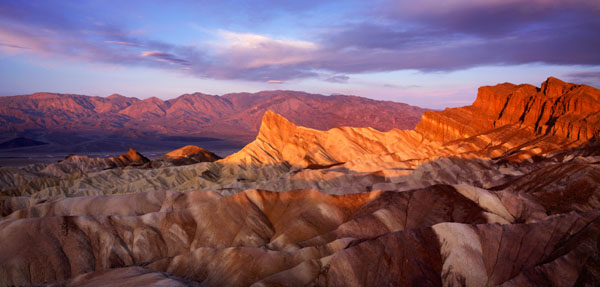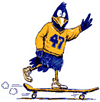
One of Professor Char Miller’s latest books, Death Valley National Park: A History, is a co-authored volume based on the manuscript drafted by late UNLV History Professor Hal K. Rothman. Hal was an editor for the Environmental History journal and was a prominent writer, public speaker and environmental historian; he died from ALS (Lou Gehrig’s disease) in 2007 at the age of 48.
Death Valley National Park: A History is the first comprehensive history of the park, from its beginning as a national monument in 1933 to its present day prospects and conflicts. The book discusses the three-million-acre park’s founding, evolution and early people, and it also examines the past and current impacts of mining, solar power, politics and urban development on this arid landscape. Here, Professor Miller, director of the Environmental Analysis Program at Pomona College, discusses the book in an abridged and edited interview.
Q: How did you become involved with Hal Rothman?
“I went to an environmental history conference in Houston in the late 1980s. He walked up to me, introduced himself, and said ‘I know there’s a piece you’ve sent to us that should be published. But you need to rewrite it and send it to me.’ The relationship started there. We had some very good interactions as scholars and friends, and so it was a joy to be able to do this project. The amazing thing about Hal is I think he’s had five books published after his death. It’s partly because people have been tremendously supportive of his memory, and he was tremendously prolific.”
Q: What inspired him to write the book?
“Hal wrote histories for the National Park Service. This one was particularly important to him because he lived in Las Vegas, and I think the project was deeply meaningful in a spatial sense. It was a landscape he knew well. Part of what I wanted to do when I edited and revised the book was to bring that part to the fore. It deals much more with things he was really interested in, first of all the land itself, secondly the chapter about the Timbisha people.”
Q: Why did you decide to take the challenge of finishing what Hal started?
“The book was really something that his wife thought that Hal would want published, so I wanted to fulfill that wish. The original manuscript was drafted, but because he was diagnosed with ALS shortly thereafter, there was no way he could work on it. I started reading it and realized it had the potential for a really fabulous book. The trick was to figure out how to write it as closely as I could (and I don’t think I completely succeeded) in the way he put words down on a page. He was a quick and good writer, and I wanted to replicate the same kind of pop in the prose as best I could do it. Clearly as an editor/reviser/co-author, there were things that needed to be changed, but I retained his voice as much as was possible.”
Q: Have you been to Death Valley? What’s it like?
“One of the things that is the most staggering about Death Valley is its immensity. It’s three million acres, which makes it the largest national park in the continuous 48 states, but it’s bigger than three million acres visually. Wherever you’re standing, whether it’s Zabriskie Point or any of the other landmarks, you can see way beyond the park’s boundaries, and you get a really clear sense for why it’s called Death Valley. That is reflected in the book’s cover: It’s two photographs we picked and melded together, but both of them are from the perspective of far away. That was really what I was going for with the cover, was to say, ‘This is a place that’s beyond our capacity to imagine.’”
Q: What kinds of challenges has Death Valley faced in the 21st century?
“Imagine, for example, you have a park that has been underfunded for the whole of its history, as Death Valley has, that has never had the full staffing that it needs. The lesson that I drew from that is that this park, in an age of slashed budgets, can teach its peers in the park service a lot of things about how to live lean. It is increasingly being impinged upon by urban development. It’s not only finding human population where it never was before, but this is also the desert that’s being solarized [used for solar power]. It turns out that this place that seems so far off the map is central in the 21st century, and resolving some of those problems is really going to be the job of that park service across the 21st century.”
Q: Why should someone visit Death Valley?
“For most Americans who don’t live in deserts, it is such a different physical experience. It’s a very sensory experience, the lack of sounds, the lack of trees and grass, but these lacks become positive because it reminds you of the land you come from. Death Valley in particular is valuable because it also helps tell a story of the human relationship with these deserts across time. You get a sense for the different ways by which human cultures could live on even an intensely arid landscape.”
Q: Who is your audience?
“It has multiple audiences, the biggest of which are the million-plus visitors that go to Death Valley every year. My goal was to write a book that was less than 200 pages that had some illustrations and that would capture the imagination of a disparate audience who believes in reading. I’m really writing for people who are well educated, well read, and who have time to read, that’s the audience. Because the parks are so beloved in the U.S., I hope those people will have a deeper understanding for why they love the landscapes the ways that they do.”
Q: Timeline of writing the book?
“I knew about the project in the early 2000s, but because Hal had ALS, it became clear that was not the project he was going to finish. In 2010, Hal’s wife, Laura Lee Rothman went to the University of Nevada Press and said there’s this manuscript, is there anything we can do with it? That’s when they approached me, knowing my relationship with him. In 2011, I reread the project, wrote a review of the book for the press, and then I realized 2013 is the 80th anniversary of the Death Valley National Monument. I said, let’s get this out in 2013, and they said, you’ve got a year.”
Q: Any future book plans?
“I’m on leave this fall to begin work on a project that’s about the public lands system. I’m working with a photographer, Tim Palmer, to look at these landscapes, wild and managed. My job as the writer is to write a narrative about 30 national forests and grasslands that approaches them as physical landscapes, as cultural resources, and that tells the stories of the earliest people who lived within these landscapes. I’m going to really take my cues from Tim’s photographs. For me it’s going to be a deeply aesthetic project where the words will follow the images.”


